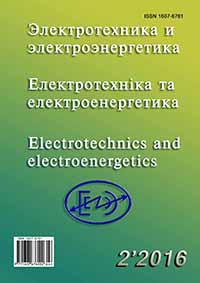FEATURES OF THREE-DIMENSIONAL SIMULATION OF THE ELECTROMAGNETIC FIELDS OF THE ASYNCHRONOUS MOTORS
DOI:
https://doi.org/10.15588/1607-6761-2016-2-5Keywords:
three-dimensional simulation, asynchronous motor, short-circuit, electromagnetic field, finite element method, approximating functions, the energy of the magnetic fieldAbstract
Purpose. Development of new effective approach for the realization of three-dimensional mathematical model of transient electrical and magnetic fields in induction motors, which based on their design features, the nonlinearity of the electrical and magnetic properties of the active and structural materials, which provides adequacy or high simulation accuracy.
Research methods. Numerical simulation of the conjugate spatial transient electrical and magnetic fields of the induction motor in the mode of short-circuit, with the help of methods of the theory of electromagnetic fields, finite element, theory of electrical machines and electrical circuits.
The obtained results. Theoretical researches and simulation results, which based on numerical realization of the finite element method of three-dimensional mathematical model of the induction motor are obtained. Theoretical researches indicate the features of electrical and magnetic processes of AC power conversion in a short circuit mode. In the area of the coil ends of the low power asynchronous motor it is allocated to 12,5% of the total energy of its magnetic field, which is mainly localized in the active part of the stator, the rotor and the air gap. In the central area of the active part of the induction motor, the length is up to 60% of the total length of the stator and rotor core, the magnetic field has plane-parallel form, but is transformed into zones of coil ends of the stator windings, and near of its core end. The features of the magnetic field and energy distribution, which have a significant effect on the parameters of a short-circuit of small power induction motor and its operating modes are defined.
Scientific novelty. The regularities of the distribution of the induction and magnetic field energy in the short-circuit mode and their quantitative relation for active zone and the area of the coil ends of the stator windings of the low-power asynchronous motors are defined.
Practical significance. A new approach for three-dimensional simulation of the electromagnetic process in the induction motor, which consists in differentiating the size of the finite elements and use of approximation functions of Lagrange polynomials based on finite element method are realized. It provides high convergence of numerical realization of short-circuit mode transient processes, reducing the computation time, the requirements for computing resources and high simulation accuracy. Comparison of the energy values of the induction motor magnetic field in short-circuit mode shows, that for Lagrange polynomials approximating the first degree, the relative error do not exceed 3,8% as compared with approximating polynomials of the third degree, while reducing the calculation time in 389 times and requirements for the computational resources – up to 10 times.
References
Kopulov I. P. Matematicheskoe modelirovanie electricheskih mashin. Moscow, Vysshaya shkola, 2001, 327 p.
Кopulov I. P., Klokov V. К., Morozkin V. P. Proektirovanie elektricheskih mashin. Moscow, Vysshaya shkola, 2005, 767 p.
Тolochko О. I. Rozkaryaka P. I., Zhurov I. O. Modelirovanie asinchronnogo dvigatelya pri obruve fazu statora , Electrotechnical and computer systems, No 15 (91), 2014, pp. 262–266.
Persova М. G., Soloveychik Yu. G., Temlyakova Z. S. O novom podhode k proektirovaniyu elektricheskih mashin na osnove chislennogo modelirovaniya, Elektrotehnika, No 9, 2007, pp. 15–21.
Vaskovskiy Yu. V., Geraskin A. A. Matematicheskoe modelirovanie elektromagnitnyih poley v korotkozamknutom asinhronnom dvigatele s povrezhdennoy obmotkoy rotora, Tehnicheskaya elektrodinamika, No 2, 2012, pp. 56–61.
Zamchalkin, A. S., Tyukov V. A. Chislennoe modelirovanie protsessa puska asinhronnogo dvigatelya. Dokladyi TUSURa, No 1(25), 2012, pp. 171–177.
Milyih V. I., Polyakova N. V. Analiz garmonicheskogo sostava peremennogo magnitnogo polya, svyazannogo s vraschayuschimsya rotorom turbogeneratora, v rezhime holostogo hoda i korotkogo zamyikaniya, Elektrotehnika i elektroenergetika, No 2, 2013 , pp. 5–12.
Plyugin V. E. Chislennoe modelirovanie elektromagnitnogo polya asinhronnogo dvigatelya s vneshnim massivnyim rotorom,Vestnik NTU KHPI, No 51(1024), 2013, pp. 66–75.
Mogilnikov B. C., Oleynikov A. M., Strelnikov A. N. Asinhronnyie dvigateli s dvuhsloynyim rotorom i ih primenenie. Moscow, Energoatomizdat, 1983, 120 p.
Yarymbash D. S., Kilimnik I. M. Osobennosti modelirovaniya elektromagnitnyih protsessov v induktore kalibra mundshtuka pressa, // Visnik kremenchutskogo derzhavnogo politehnichnogo universitetu, Vol. 1, No 4(45), 2007, pp. 53–55.
Zenkevich O., Morgan K., Konechnyie elementyi i approksimatsiya. Moscow, Mir, 1986, 318 p.
Yarymbash, D., Yarymbash, S., Divchuk, T., & Kylymnik, I. (2016). Determination features of the power transformer short circuit parameters through field modeling. Electrical Engineering And Power Engineering, 1, 12-17.
Downloads
How to Cite
Issue
Section
License
Copyright (c) 2017 D. S. Yarymbash, M. I. Kotsur, S. T. Yarymbash, I. M. Kotsur

This work is licensed under a Creative Commons Attribution 4.0 International License.
Creative Commons Licensing Notifications in the Copyright Notices
Authors who publish with this journal agree to the following terms:
Authors retain copyright and grant the journal right of first publication with the work simultaneously licensed under aCreative Commons Attribution License that allows others to share the work with an acknowledgement of the work's authorship and initial publication in this journal.
Authors are able to enter into separate, additional contractual arrangements for the non-exclusive distribution of the journal's published version of the work (e.g., post it to an institutional repository or publish it in a book), with an acknowledgement of its initial publication in this journal.
Authors are permitted and encouraged to post their work online (e.g., in institutional repositories or on their website) prior to and during the submission process, as it can lead to productive exchanges, as well as earlier and greater citation of published work.

